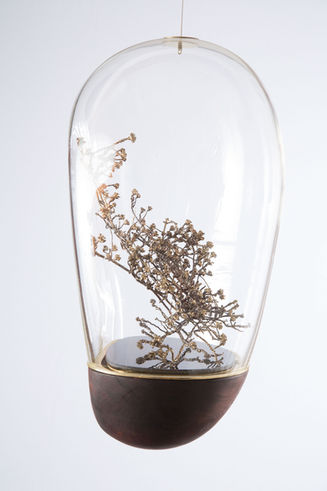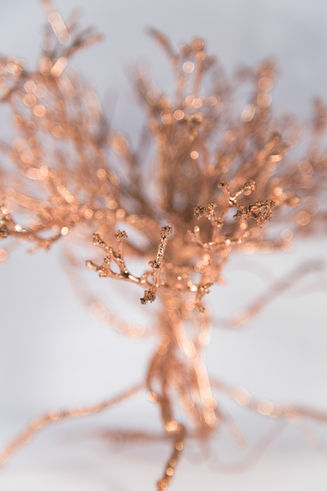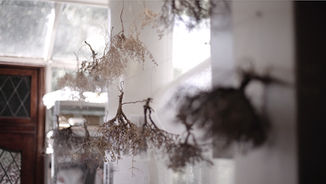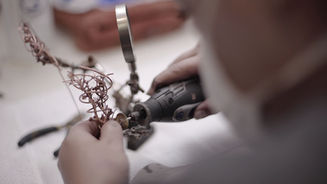OVERVIEW
Through the interplay of light and glass, the artist has discovered the physical means to share this ethereal connection to ‘other' worlds of light. Glass, a material that so closely speaks of specificity of place, of the earth from which it is created, and of light that so transforms the physical world, invoking, involving and exposing just how near the magically foreign is.
In 2017, Ronél de Jager received the Kanna Award for her multimedia exhibition titled ‘Broeigrond: Fertile ground for golden regrets’.
The show featured the artist's first foray into sculptural practice with a five-work series titled ‘Citizen of Glass'. Each work is a suspended, hand-blown glass bulb containing a precious sample of electroplated Karoo flora.
In the electroplating process, an object is submerged into a chemical solution which transfers nano metal particles onto the flora. Dendritic metallic crystals form on the edges of the surface as the organic object is charged with electricity, forming new fractal patterns. These patterns echo the shapes of flora.
The small units of biological material captured the delicacy and fragility of life and yet also reflected the tenacity of the biological that finds its niche in inhospitable geographies.
‘Citizen of Glass’ is, on the one hand, an expression of the fragility of the human being and also of the threatened nature of our ecology. It speaks of the novel and precariously balanced solutions of life in relation to environment. There is, however, another side. Each globe bares an individual title: Venus, Mars, Jupiter, Saturn and Mercury. This subtitling reveals De Jager moving the meaning beyond simply recording and capturing fragile flora. The barrenness of the Karoo landscape has been the subject of much literature, from Pauline Smith to Herman Charles Bosman. But it was a 19th-Century poem by Thomas Pringle, ‘Afar in the Desert’, that possibly first captured the otherworldly, forbidding nature of the space:
“A region of drought, where no river glides,
Nor rippling brook with osiered sides;
Where sedgy pool, nor bubbling fount,
Nor tree, nor cloud, nor misty mount,
Appears to refresh the aching eye;
But the barren earth, and the burning sky,
And the blank horizon, round and round,
Spread, void of living sight or sound.”
By twinning these pieces of transformed flora with the names of planets from our solar system, De Jager suggests the alien quality of the Karoo, and how parts of it resemble an alien landscape. In this naming, there is also a warning: that our mistreatment of Earth could result in it becoming inhospitable like the planets De Jager lists. As such, the Karoo, and De Jager’s sculptures, become microcosms of a broader system that could move towards entropy should we as a species not change our way of being.
It is now 2020 and the influence which ‘Citizen of Glass' exerted over De Jager’s work has not abated. In the darkened room of the ‘Broeigrond' exhibition, the interplay between the materials and light, the immersive aptitudes, hidden in the work when shadows co-opted the viewers and cast them not only as a participant but a component of the work, meant that further exploration and development of this body of work was a certainty.
INSTALLATION (DEMONSTRATION)

VIDEO DEMONSTRATION

SELECTED WORKS

NGWENYA GLASS, ESWATINI
These microscopic beads of impurities behave like raindrops; bending, refracting, reflecting a cosmic show of scattering light.
De Jager’s first five-work sculpture series ‘Citizen of Glass’ was first produced in collaboration with the Johannesburg based glass blowing studio, Molten Glass in 2017 for her second solo exhibition ‘Broeigrond: Fertile Ground for Golden Regrets’.
In August 2018 De Jager visited Ngwenya Glass in Eswatini to collaborate on this new dimension of the project. Together with master glass blowers James Magahula, Isaac Mamba, Nathi Shongwe, Hope and Chas Prettejohn, 14 glass bubbles were blown for the individual components of the work.
Ngwenya Glass crafts their products from 100% recycled glass, and their glass-blowing studio houses the largest glass furnaces in Africa. These factors informed De Jager’s decision to collaborate with the studio on this next phase of this project. Using a ‘free-blowing’ glass forming technique allowed the team to experiment with larger and more irregular shapes and sizes than De Jager’s previous five-vessel series. During the molten phase, Karoo soil is embedded in the molten glass to create ‘impurities’ which are invisible to the eye when viewing the vessel from up-close. These microscopic beads of impurities behave like raindrops; bending, refracting, reflecting a cosmic show of scattering light. The soil is invisible, but present. It is pure vision masquerading as matter; the works are a reminder that all appearances are determined by a relationship between subject, light, and space.

ELECTROPLATING PROCESS
These build-ups are called dendrites and when left for a long period of time the copper metal particles “grow”, reflecting the innate metallic properties one would find in the metal’s natural form.
Electroplating is a plating process in which metal ions in solution are moved by an electric field to coat an electrode. The process uses electrical current to reduce cations of a desired material from a solution and coat a conductive object with a thin layer of the metal. Electroplating is primarily used for depositing a layer of material to bestow a desired property (e.g., abrasion and wear resistance, corrosion protection, lubricity, aesthetic qualities, etc.) to a surface that otherwise lacks that property.
De Jager experimented with this process to achieve a specific, desired effect; when copper metal ions deposit at controlled voltage, the copper deposit builds up on the sharp excursions of the flora. These build-ups are called dendrites and when left for a long period of time the copper metal particles “grow”, reflecting the innate metallic properties one would find in the metal’s natural form.





































